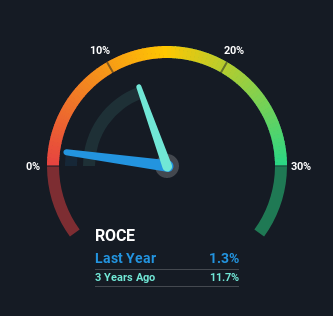- India
- /
- Commercial Services
- /
- NSEI:KOKUYOCMLN
Kokuyo Camlin (NSE:KOKUYOCMLN) Will Be Looking To Turn Around Its Returns

When it comes to investing, there are some useful financial metrics that can warn us when a business is potentially in trouble. More often than not, we'll see a declining return on capital employed (ROCE) and a declining amount of capital employed. Ultimately this means that the company is earning less per dollar invested and on top of that, it's shrinking its base of capital employed. In light of that, from a first glance at Kokuyo Camlin (NSE:KOKUYOCMLN), we've spotted some signs that it could be struggling, so let's investigate.
Return On Capital Employed (ROCE): What is it?
Just to clarify if you're unsure, ROCE is a metric for evaluating how much pre-tax income (in percentage terms) a company earns on the capital invested in its business. Analysts use this formula to calculate it for Kokuyo Camlin:
Return on Capital Employed = Earnings Before Interest and Tax (EBIT) ÷ (Total Assets - Current Liabilities)
0.013 = ₹33m ÷ (₹3.6b - ₹1.0b) (Based on the trailing twelve months to December 2021).
Therefore, Kokuyo Camlin has an ROCE of 1.3%. Ultimately, that's a low return and it under-performs the Commercial Services industry average of 8.1%.
View our latest analysis for Kokuyo Camlin

While the past is not representative of the future, it can be helpful to know how a company has performed historically, which is why we have this chart above. If you'd like to look at how Kokuyo Camlin has performed in the past in other metrics, you can view this free graph of past earnings, revenue and cash flow.
The Trend Of ROCE
In terms of Kokuyo Camlin's historical ROCE movements, the trend doesn't inspire confidence. Unfortunately the returns on capital have diminished from the 5.0% that they were earning five years ago. On top of that, it's worth noting that the amount of capital employed within the business has remained relatively steady. Since returns are falling and the business has the same amount of assets employed, this can suggest it's a mature business that hasn't had much growth in the last five years. If these trends continue, we wouldn't expect Kokuyo Camlin to turn into a multi-bagger.
On a side note, Kokuyo Camlin has done well to pay down its current liabilities to 29% of total assets. So we could link some of this to the decrease in ROCE. Effectively this means their suppliers or short-term creditors are funding less of the business, which reduces some elements of risk. Some would claim this reduces the business' efficiency at generating ROCE since it is now funding more of the operations with its own money.
The Bottom Line On Kokuyo Camlin's ROCE
In summary, it's unfortunate that Kokuyo Camlin is generating lower returns from the same amount of capital. Long term shareholders who've owned the stock over the last five years have experienced a 24% depreciation in their investment, so it appears the market might not like these trends either. Unless there is a shift to a more positive trajectory in these metrics, we would look elsewhere.
Kokuyo Camlin does come with some risks though, we found 2 warning signs in our investment analysis, and 1 of those shouldn't be ignored...
If you want to search for solid companies with great earnings, check out this free list of companies with good balance sheets and impressive returns on equity.
If you're looking to trade Kokuyo Camlin, open an account with the lowest-cost platform trusted by professionals, Interactive Brokers.
With clients in over 200 countries and territories, and access to 160 markets, IBKR lets you trade stocks, options, futures, forex, bonds and funds from a single integrated account.
Enjoy no hidden fees, no account minimums, and FX conversion rates as low as 0.03%, far better than what most brokers offer.
Sponsored ContentValuation is complex, but we're here to simplify it.
Discover if Kokuyo Camlin might be undervalued or overvalued with our detailed analysis, featuring fair value estimates, potential risks, dividends, insider trades, and its financial condition.
Access Free AnalysisHave feedback on this article? Concerned about the content? Get in touch with us directly. Alternatively, email editorial-team (at) simplywallst.com.
This article by Simply Wall St is general in nature. We provide commentary based on historical data and analyst forecasts only using an unbiased methodology and our articles are not intended to be financial advice. It does not constitute a recommendation to buy or sell any stock, and does not take account of your objectives, or your financial situation. We aim to bring you long-term focused analysis driven by fundamental data. Note that our analysis may not factor in the latest price-sensitive company announcements or qualitative material. Simply Wall St has no position in any stocks mentioned.
About NSEI:KOKUYOCMLN
Kokuyo Camlin
Engages in the manufacturing, trading, and selling of stationery products in India.
Flawless balance sheet second-rate dividend payer.
Similar Companies
Market Insights
Community Narratives



